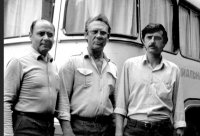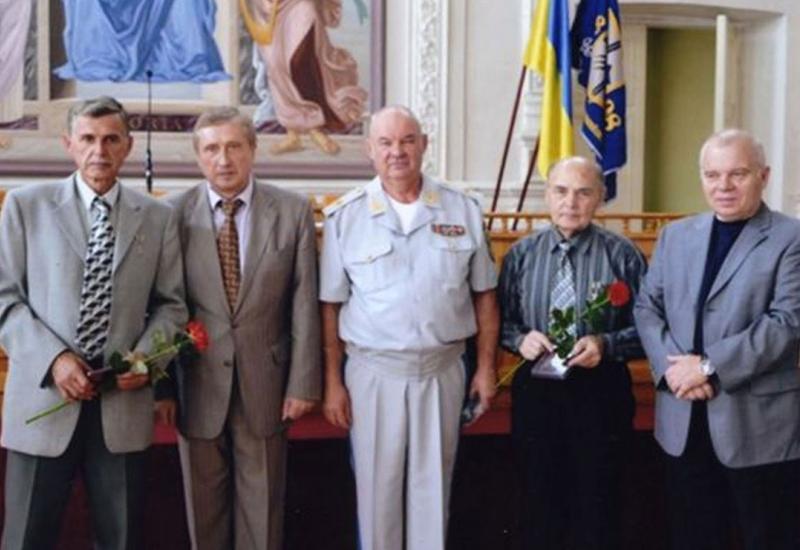On the eve of the 30th anniversary of the Chernobyl disaster the Edition "Kyiv Polytechnic" held a meeting with the first liquidators of the Chernobyl accident in our institute – PhD, associate professors A. D. Krysenko and V. P. Basov. On our demand, the scientists expressed their opinions on what was the most important in their work as liquidators of the Chernobyl accident.
The accident at the Chernobyl nuclear power plant occurred on April, 26 in 1986 at 1. 24 a.m. But the residents of the adjacent to the station areas found out thу danger much later. The most incredible rumors and guesses sprang among people. The first liquidators-fire-fighters were already dying in terrible agony, the people from Pripyat had been evacuated, and special machines were driving and washing Kyiv streets, the May 1 and the Ester were celebrated, and only then the minister of healthcare Romanenko appealed to the public with some explanations and the simplest recommendations. Why was the silence kept? First of all, all works at nuclear objects, especially accidents were placed on secret list by two stamps. Secondly, the approaching enemy was nasty, dangerous, unknown, invisible. Some time was needed to comprehend everything, to recover from panic and to prepare for a completely different, new methods of protection and fight. And we were running out of time.
We, as radiochemistry laboratory researchers of the HTF "KPI", specialists in work with opened radio nuclides, after finding out from unofficial sources about the accident at the nuclear facility, using appropriate equipment began examining the radioactive background and measuring the radioactivity on the leaves of trees, grass, ground in the flowerbeds, water from puddles, etc. The most dangerous was the dust that settled on the outside of glass windows. Insidious threat was penetrating the room. And we, at our own risk began to recommend to our relatives and acquaintances some simple rules of safety.
 Meanwhile, at the prof. I. M. Astrelin department a group (later - the Research Laboratory) led by senior scientist Alexander Petrovych Shutko was working to develop new chemical reagents. Here the reagents for deep cleaning of both natural and industrial waste water using basic aluminum salts were designed. "Boys, - turned to us Alexander Petrovych – why are you draggling here? We know, understand and, more importantly, we can. Let's think and do something, let's try our reagents for radiation." We thought, tested "for radiation" our model examples of "dust" flushed water from the window and got excellent cleaning effect. We a rough plan of actions, and Alexander Petrovych addressed the plan to the Civil Defence Headquarters (CD) KPI, then we were directed to the district and then also to the city headquarters of CD.
Meanwhile, at the prof. I. M. Astrelin department a group (later - the Research Laboratory) led by senior scientist Alexander Petrovych Shutko was working to develop new chemical reagents. Here the reagents for deep cleaning of both natural and industrial waste water using basic aluminum salts were designed. "Boys, - turned to us Alexander Petrovych – why are you draggling here? We know, understand and, more importantly, we can. Let's think and do something, let's try our reagents for radiation." We thought, tested "for radiation" our model examples of "dust" flushed water from the window and got excellent cleaning effect. We a rough plan of actions, and Alexander Petrovych addressed the plan to the Civil Defence Headquarters (CD) KPI, then we were directed to the district and then also to the city headquarters of CD.
At the same time, the radiation was approaching to the city much faster than it had been expected. The threat came from the roads connecting Kyiv and Polyssia region with wheels of transport. Sanitization units were immediately installed at eight entrances to the city transport platforms where cars were washed on the special trestles with washing detergent solutions. The water flew into the concrete tanks storage with 50-200 m3 capacity or cistern-pits lined with foil. At these units the construction of residential treatment facilities was started, where the contaminated water was to pass multi-stage cleaning from dozens of different radio nuclides.
Unfortunately, making each object suitable for practical application required several months of hard work, and storage containers were filling with water very quickly. For a few weeks (!), the situation had become a stalemate. A new or additional original solution was needed urgently. This solution was proposed by us.
In the city CD headquarters we were supplied us with real water from "Demidov" unit, and a few days later, Alexander Petrovych illegally reached to the water storage of cooling water at the 4th unit of Chernobyl power plant, and took a canister of water for research. The results were encouraging: the effect of cleaning of the total and radio nuclides radiation for 2-3 points of magnitude. Such water could be used for technical needs, and we were allowed to field trials and got a task to create a real technology.
The basis of the technology (later it received the official title "KPI Technology") was founded not only on the recipes, but also on original equipment design. We proposed to construct mobile plants (to clean water in the storage tanks on wheels. In two weeks such devices were installed in Kyiv factories, and in. reagent party was made with our recipe in Rubizhne.
June 6, 1986 by order of the head of Kyiv CD at the CD headquarters of the city was established a unit of 11 people with the official name "Water decontamination group" (unofficial name – "Shutko Group"), which dealt with all issues of water decontamination after washing the contaminated vehicles during 1986-87. The press reported about this work in a very careful and veiled way. The temporary equipment-washing items in the 30-kilometer zone were created just in the field, in the open area. Radioactive water was dripping on the ground in a hastily dug wells, including lake-cliffs from which radiation could pass depthward and become a threat of global pollution of underground water horizons. No other way existed at that time. A continuous stream of transport was moving from the zone and it had to be thoroughly washed. The total amount of water contaminated with radio nuclides was measured in thousands cubic meters. Our group was sent to such lakes.
Today we can estimate he most significant things in the liquidation of the Chernobyl accident with our participation, we should highlight three points. The first point practical-engineering. Our technology, proposed in time, was widely recognized by the liquidators. Elements of "KPI Technology" were implemented at the Vilcha station of the South Western railway for washing the trains leaving the Chernobyl area, in Belarus, according to the State Commission decision, it was used at powerful units in the 30-kilometer zone, started been used by the CD USSR troops.
The second point was economic. In 1986 direct financial savings in prices amounted to more than 18 million rubles due to the introduction of technology only in Kiev region.
The third point was social (in our opinion – the most important one). The strategy of deactivization of any volume of water contaminated with radio nuclides in the conditions of high background radiation, and of environmental pollution by the open point sources of ionizing radiation was completely change due to our developments. The decontamination group came to the facility by call, then they were working for several hours (cleaned water and analyzed the results), gave the green light to release the storages and left the danger zone. This eliminated the need for planned stationary cleaning plants. Their construction was stopped, and the built ones were preserved. The need for hundreds of people who would work on the construction sites, contaminated by radio nuclides, disappeared. Moreover, the workers would receive radiation from the open sources into the body by inhaling radioactive dust and aerosols. The need for stuff for these buildings also eliminated. Working there meant at least three, and even four shifts per day for each unit and the number of such people would be more than a thousand.
 Thus, introduced at that time "KPI Technology " to some extent preserved natural aquatic ecosystems from significant contamination with radio nuclides and protected the health of many
Thus, introduced at that time "KPI Technology " to some extent preserved natural aquatic ecosystems from significant contamination with radio nuclides and protected the health of many
The engineering training of the next generations is also important. The Department of TNR and ZHT (the head prof. I. M. Astrelin), where during the "Chernobyl days" we created and tested their reagents, is preparing highly qualified specialists of related scientific and practical specialty on water treatment and water purification. The results of our group work, known in the whole USSR, helped O. P. Shutko brilliantly doctorate at the Moscow Chemical-Technological Institute. n. a. D. I. Mendelyeyev, and create the first Department of the industrial ecology in Ukraine in the Kiev Polytechnic Institute, which is now headed by Professor M. D. Homelya. For the time being, at the Department a powerful school of young scientists and engineers-environmentalists working in the field of industrial ecology and environmental protection.
It has been 30 years since those tumultuous days. A new generation of our people has grown and matured. As ever patriots volunteers were attacking on the blazing reactor, now patriots and volunteers enter an unequal battle with the "big brother" – the Russian invaders. That is, every generation has its own challenges. The Chernobyl disaster was our war with the invisible and insidious enemy. Although human losses were carefully concealed at that time, they can be estimated by dramatically increased territories of significantly "looking younger" cemeteries. The ranks of our "Water decontamination group" has also become smaller. A few days before the tenth anniversary of the Chernobyl event the head doctor of technical sciences, professor, head of Ukraine's first Chair of Industrial Ecology Alexander Petrovich Shutko passed away in the prime of his life and creative ideas. May the memory of him live forever.

